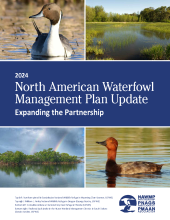
Executive Summary
The North American Waterfowl Management Plan (NAWMP) or “the Plan”) began as a response to declining waterfowl populations and has served as the foundation for continental conservation of waterfowl and their habitats for nearly four decades in Canada and the United States, and for three decades in Mexico. The N A W M P partnership has been adaptive and extraordinarily successful in its efforts. Much of the N A W M P’s work is conducted by regional Joint Ventures (J Vs) in the United States and Canada. Two J Vs also operate in Mexico, but much of the work there is conducted in Management Units for Wildlife Conservation (U M As; see Appendix A for a map of existing J Vs and U M As). In Mexico, the federal government owns all waterbodies; naturally, these are critical for accomplishing N A W M P goals.
This 2024 N A W M P Update reviews the progress made toward achieving the goals outlined in the 2012 Revision, as detailed
in the 2014 Addendum (N A W M P 2014) and further refined in the 2018 Update. It also offers recommendations for decisionmakers within the waterfowl management community that address changing conditions and new opportunities for conservation success. The N A W M P has an unprecedented opportunity to engage current and potential new partners and ramp up its efforts to achieve goals for waterfowl populations, habitats and people.
Despite the success of the N A W M P and relatively high current population numbers, waterfowl habitat losses continue at scales and rates that challenge the N A W M P’s goal to sustain continental waterfowl populations. The landscapes that support waterfowl are not static; they change dramatically through natural wet/dry cycles and are increasingly affected by human influences, such as agricultural intensification, urban and industrial development, and increased demands for water. Additionally, climate change introduces both known (e.g., sea-level rise) and less understood impacts that may exacerbate the challenges the N A W M P faces in sustaining habitats for waterfowl, other bird species and overall biodiversity. Wetland loss remains a pervasive threat. A recent study of the status and trends in the United States reported a 50% increase in loss from 2009 to 2019 compared to the previous 10-year period. Approximately 670,000 acres of palustrine vegetated wetlands were lost during the period, including substantial losses of prairie pothole wetlands (Lang et al. 2024). In Canada, many jurisdictions lack comprehensive legislation for wetland protection, and recent judicial rulings in the United States will likely weaken protections there. The N A W M P partnership must seek innovative means to increase the rate and scale of habitat conservation and restoration across the continent, and it must do so rapidly to sustain waterfowl populations at desired levels.
Perhaps nowhere is the challenge of habitat loss more acute than in the Northern Great Plains, where a significant proportion of continental waterfowl are produced annually. Across the Great Plains, grassland loss approaches 70%, with 32 million acres lost since 2012, and 1.6 million acres lost in 2021 alone (World Wildlife Fund 2023). Loss of grasslands in the Prairie Pothole and Prairie Habitat Joint Ventures has been estimated to occur at an alarming rate of 0.23% annually. Over the next decade, undisturbed grassland is projected to be lost at a rate 7 to 25 times faster than rates of protection (Fields and Barnes 2019).
Read the full document via the link below.
